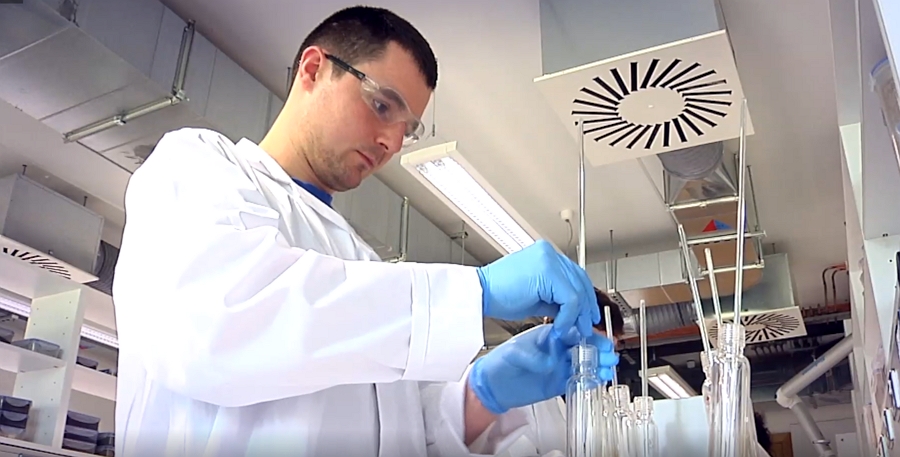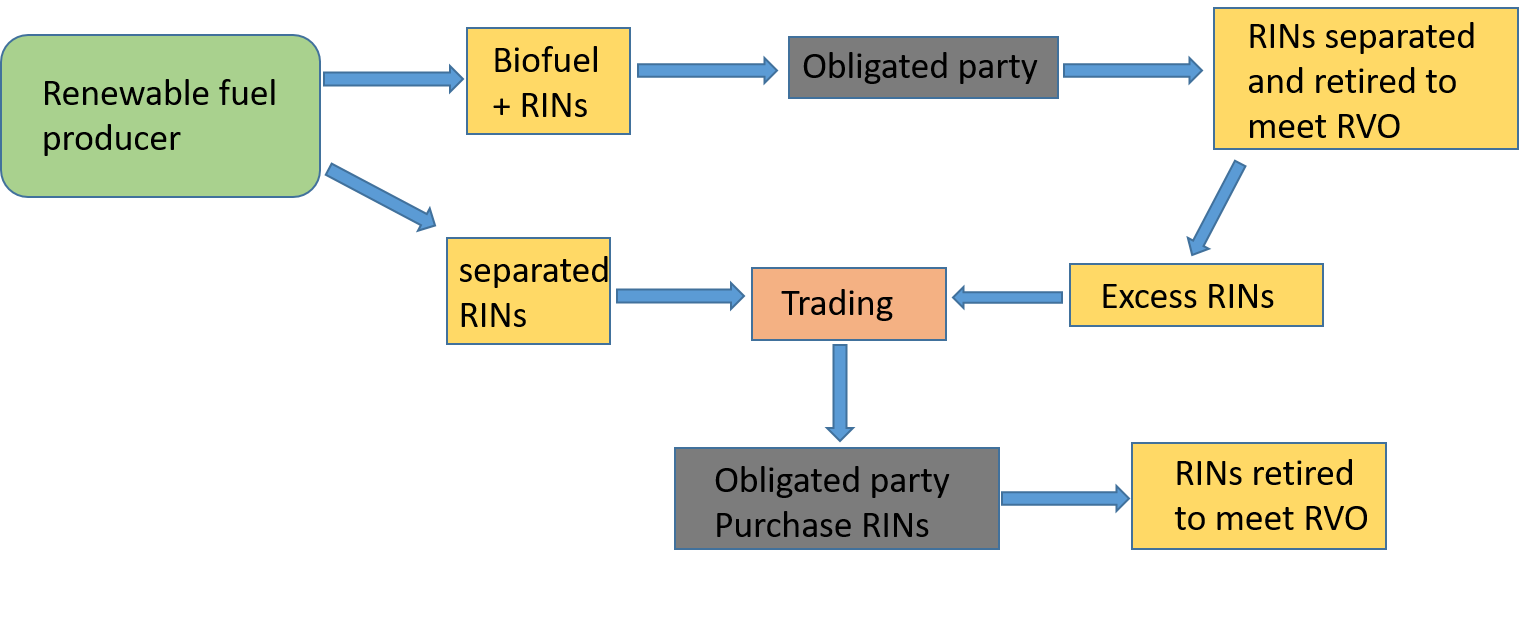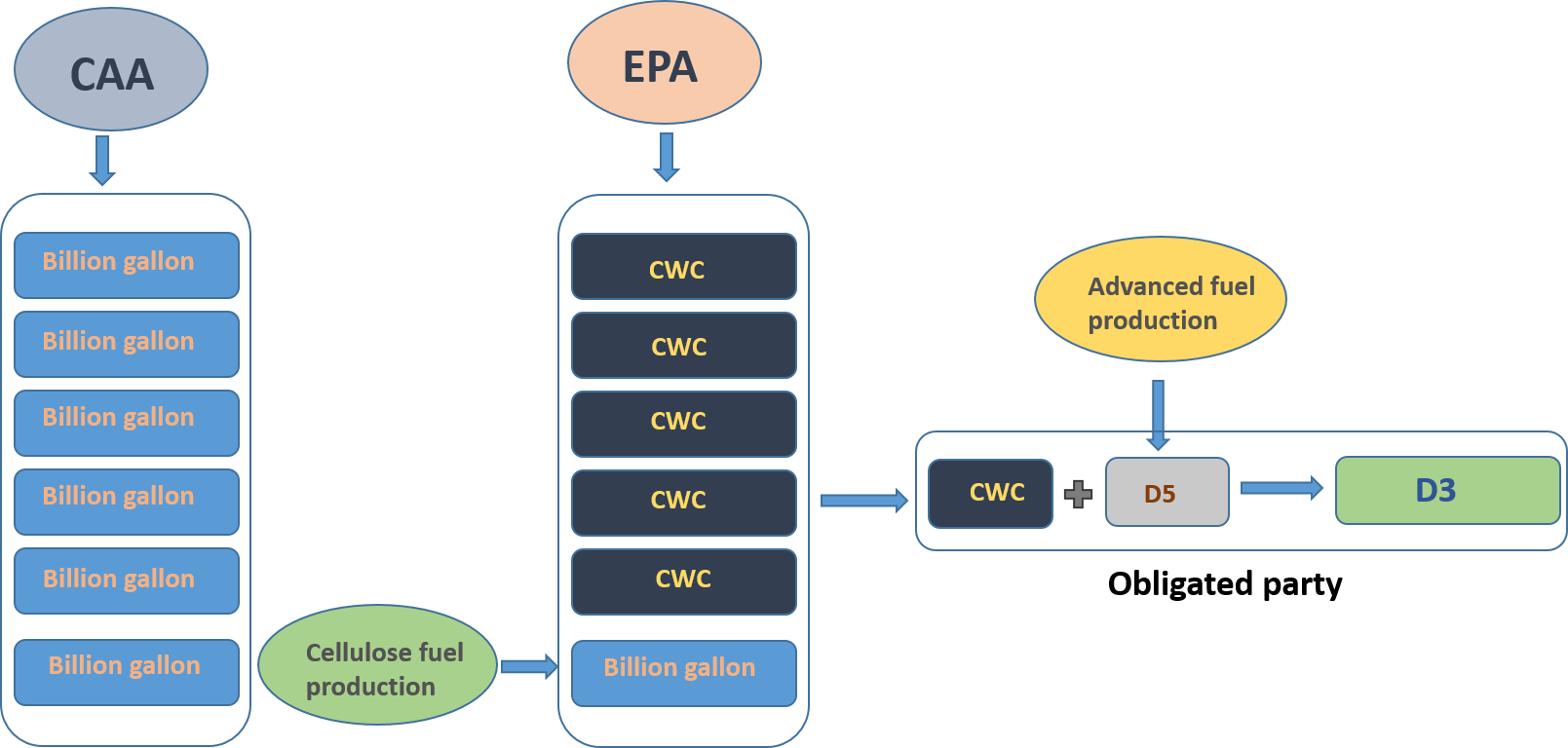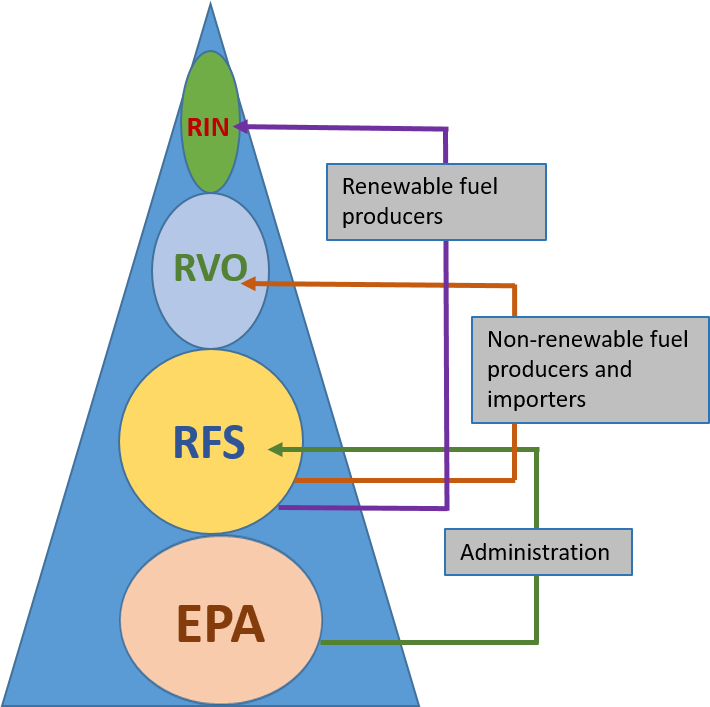Feedstock Analysis for RINs Credits
To increase the renewable energy usage in transportation fuel, the Renewable Fuel Standard (RFS) was created in the Energy Policy Act of 2005 (RFS1)
and was revised in 2007 (RFS2). RFS is administered by Environmental protection agency (EPA) by using Renewable Identification Numbers (RINs)
and Renewable Volume Obligations (RVOs) as tools. RVOs are volume targets for producers and importers of petroleum-based gasoline or diesel fuel (obligated parties),
while RIN gives flexibility in the ways to demonstrate that they have complied with the annual RVO.
RINs are credits used for compliance and the currency of RFS program. They are saleable regulatory credits that represent a quantity of qualifying renewable fuel. To qualify as a renewable fuel under RFS program, a fuel should be produced from the approved feedstock through an approved pathway. For any approved feedstock there may be many approved conversion processes. RINs are generated when producer makes a gallon of renewable fuel and are attached to it. Obligated parties should blend the renewable fuel in to fuel derived from petrol or purchase RINs credits to meet their specified annual volume obligation.
RINs are credits used for compliance and the currency of RFS program. They are saleable regulatory credits that represent a quantity of qualifying renewable fuel. To qualify as a renewable fuel under RFS program, a fuel should be produced from the approved feedstock through an approved pathway. For any approved feedstock there may be many approved conversion processes. RINs are generated when producer makes a gallon of renewable fuel and are attached to it. Obligated parties should blend the renewable fuel in to fuel derived from petrol or purchase RINs credits to meet their specified annual volume obligation.
There are five different types of individual RINs based on the fuel type, feedstock and greenhouse gas (GHG) reduction requirement:
| Category | Code | GHG Reduction Requirement | Description |
|---|---|---|---|
| Cellulosic Biofuel | D3 | 60% | Any biofuel made from cellulose, renewable gasoline, biogas-derived CNG and LNG. |
| Cellulosic Diesel | D7 | 60% | Cellulosic diesel, jet fuel and heating oil |
| Advanced Biofuels | D5 | 50% | Renewable fuel other than ethanol derived from corn starch (sugar cane ethanol), biogas from other waste digesters, etc. |
| Biomass-Derived Diesel | D4 | 50% | Meets the definition of either biodiesel or non-ester renewable diesel. |
| Renewable Fuel | D6 | 20% | Produced from renewable biomass and is used to replace quantity of fossil fuel present in transportation fuel, heating fuel, or jet-fuel (e.g. Corn ethanol) |
Cellulosic biofuel (D3) and bio-based diesel (D4) are nested under advanced biofuels, while bio-based diesel can also be cellulosic diesel (D7)
if it is made from cellulosic feedstock. Advanced biofuel itself is nested under total renewable fuels. Total renewable fuel can be satisfied by producing
any type of renewable fuel, while advanced biofuel is satisfied by D3, D7, D5 and D4 categories. Bio-based diesel volume requirements can be satisfied by the diesel from
non-cellulosic or cellulosic feedstock (D4 and D7), but cellulosic biofuels (D3) volume targets are strictly met by fuels made from cellulosic feedstock.


The Clean Air Act specifies national volume targets of renewable fuel that are intended to be achieved under RFS program each year. The targets for 2018 are given below.
* - All values are ethanol-equivalent on an energy content basis, except values for BBD which are given in actual gallons.

| Type of Renewable Fuel | Billion Gallons* |
|---|---|
| Cellulosic Biofuel | 7 |
| Biomass-Based Diesel | >1 |
| Advanced Biofuel | 11 |
| Renewable Fuel | 26 |
* - All values are ethanol-equivalent on an energy content basis, except values for BBD which are given in actual gallons.

The CAA provides EPA with the authority to calculate and enact final volume requirements considering shortfalls and growth of the biofuel industry.
Slow growth of cellulosic biofuel industry has become a challenge or hurdle to meet the applicable volume targets. EPA used “cellulosic waiver authority”
provided by the statute to reduce the volume requirements for 2018 (see the table below). It is mentioned that “While we are reducing the required volume of total renewable fuel,
advanced biofuel and cellulosic biofuel below statutory levels, the required volumes in this rule would achieve the implied statutory volumes for conventional biofuel and non-cellulosic advanced biofuel for 2018”.
All values are ethanol-equivalent on an energy content basis, except values for BBD which are given in actual gallons.
| 2018 | 2019 | |
|---|---|---|
| Cellulosic Biofuel (million gallons) | 288 | N/A |
| Biomass-Based Diesel (billion gallons) | 2.1 | 2.1 |
| Advanced Biofuel (billion gallons) | 4.29 | N/A |
| Renewable Fuel (billion gallons) | 19.29 | N/A |
All values are ethanol-equivalent on an energy content basis, except values for BBD which are given in actual gallons.
To register for the RFS and acquire RINs credits for the fuel produced or imported, the following sections under RFS should be reviewed to ensure that company or importer meets the qualifications:
EPA evaluates case-by-case through the registration process and expects that any company that registers to generate RINs must be in a position to provide all necessary documentation.
This includes type of feedstock, biofuel pathway, production process and energy demands, etc. Independent third-party Engineering Review (ER) report should be submitted from all renewable fuel and
foreign ethanol producers.

RINs are traded in two forms. The first one is assigned RINs which is directly associated with a batch of fuel from party to party and purchasers obtain both renewable fuel and
RINs together. The second one is separated RINs which are separated from the batch of renewable fuel produced and traded separately.
Renewable fuel producers generate RINs, market participants trade RINs, and obligated parties obtain and retire RINs for compliance with annual RVOs.
EPA uses the following physical format to determine RINs for each physical gallon of renewable fuel produced in or imported into the United States:
RIN format: KYYYYCCCCFFFF BBBBRRDSSSSSSSSEEEEEEEE
Renewable fuel producers generate RINs, market participants trade RINs, and obligated parties obtain and retire RINs for compliance with annual RVOs.
EPA uses the following physical format to determine RINs for each physical gallon of renewable fuel produced in or imported into the United States:
RIN format: KYYYYCCCCFFFF BBBBRRDSSSSSSSSEEEEEEEE
- K: Identifies whether RIN is attached to gallon.
- YYYY: Year of production.
- CCCC: Company ID.
- FFFF: Plant facility ID.
- BBBB: Batch number.
- RR: Biofuels equivalence value.
- D: Renewable fuel category.
- SSSSSSS: Strat number for the batch of the biofuel.
- EEEEEEE: End number for the batch of the biofuel.
The RR value is based on the energy content and renewable content of each renewable fuel in comparison to denatured ethanol. Ethanol has equivalence value (EV) 1, while biodiesel has an EV of 1.5 because of its high energy content. RR code is EV multiplied by 10, so for ethanol RR code is 10, but for biodiesel RR code is 15 and so two biodiesel RINs can replace three ethanol RINs under the RFS mandate.
- YYYY: Year of production.
- CCCC: Company ID.
- FFFF: Plant facility ID.
- BBBB: Batch number.
- RR: Biofuels equivalence value.
- D: Renewable fuel category.
- SSSSSSS: Strat number for the batch of the biofuel.
- EEEEEEE: End number for the batch of the biofuel.
The RR value is based on the energy content and renewable content of each renewable fuel in comparison to denatured ethanol. Ethanol has equivalence value (EV) 1, while biodiesel has an EV of 1.5 because of its high energy content. RR code is EV multiplied by 10, so for ethanol RR code is 10, but for biodiesel RR code is 15 and so two biodiesel RINs can replace three ethanol RINs under the RFS mandate.
As defined by the Clean Air Act, cellulosic biofuel is “a renewable fuel derived from any cellulose, hemicellulose, or lignin that is derived
from renewable biomass and that has life cycle greenhouse gas emissions that are at least 60% less than the baseline lifecycle greenhouse gas emissions”.
Cellulosic RINs (biofuel and biodiesel) have highest RIN value, followed by biomass-based diesel, advanced biofuels and general renewable fuels, because of the specified annual RVOs by the EPA. Annual RVOs force the obligated parties to acquire specific percentage of RINs from categories of fuel that contribute to significant reductions in greenhouse gas (GHG) emissions, which are advanced fuels and cellulosic fuels.
Cellulosic RINs (biofuel and biodiesel) have highest RIN value, followed by biomass-based diesel, advanced biofuels and general renewable fuels, because of the specified annual RVOs by the EPA. Annual RVOs force the obligated parties to acquire specific percentage of RINs from categories of fuel that contribute to significant reductions in greenhouse gas (GHG) emissions, which are advanced fuels and cellulosic fuels.
All these years, EPA mandates gave higher cellulosic fuel volume requirements than the volume generated which resulted in the formulation of a
Cellulosic Weaver Credit (CWC). The CWC can be used together with advanced fuel RIN to meet the cellulosic fuel obligations of the year (D5+CWC=D3).
The CWC price is reported each year by EPA and the value is either 25c or $3-P (P= 12-month Average of whole sale prices of gasoline), whichever is greater. CWCs should be
used within the same year generated, while excess RINs can be used in the subsequent year, but only for 20% of the annual requirements. The CWC value is important, as it
also acts as a cap for D5-D3 RINs prices. Cellulosic RINs and CWC are great incentives for cellulosic fuel producers, because they can be used to determine the price of
biofuel based on the market.

Under the new rule of RFS, biofuels generated from mixed feedstock with 75% or greater adjusted cellulosic content are allowed to claim 100% cellulosic
RINs. The fuel derived from feedstocks with less than 75% adjusted cellulosic content will receive RINs only in proportion to the adjusted cellulosic content of the biomass.
The EPA also approved additional biofuels pathways under the cellulosic biofuels (D3 or D7) category. These pathways include compressed natural gas (CNG) and liquefied natural gas (LNG) produced from landfills, municipal solid waste, agriculture waste, and municipal waste water treatment facilities. For the biofuel produced from feedstock that is not approved under D3 or D7 codes, of low cellulosic content (annual cover crops), or mixed feedstock (mix of D3 and D7 approved feedstock with unapproved feedstocks), cellulosic RINs will be allotted for only adjusted cellulosic portion of the feedstock which requires accurate analysis of the chemical composition of the feedstock.
Adjusted cellulosic content is the total percentage of cellulose, hemicellulose and lignin on ash-free dry weight basis. Feedstock should be carefully fractionated for lignocellulose components, starch, free sugars, and extractives and the percentage of each fraction should be accurately determined. Only approved biomass analysis methods indicated by the EPA should be followed to analyse feedstocks for their composition. This requires expertise in chemical analysis and knowledge on various types of feedstock, as each feedstock is different in its structural matrix and fine-tuning of extraction and digestion and analysis methods is required for accurate results.
The EPA also approved additional biofuels pathways under the cellulosic biofuels (D3 or D7) category. These pathways include compressed natural gas (CNG) and liquefied natural gas (LNG) produced from landfills, municipal solid waste, agriculture waste, and municipal waste water treatment facilities. For the biofuel produced from feedstock that is not approved under D3 or D7 codes, of low cellulosic content (annual cover crops), or mixed feedstock (mix of D3 and D7 approved feedstock with unapproved feedstocks), cellulosic RINs will be allotted for only adjusted cellulosic portion of the feedstock which requires accurate analysis of the chemical composition of the feedstock.
Adjusted cellulosic content is the total percentage of cellulose, hemicellulose and lignin on ash-free dry weight basis. Feedstock should be carefully fractionated for lignocellulose components, starch, free sugars, and extractives and the percentage of each fraction should be accurately determined. Only approved biomass analysis methods indicated by the EPA should be followed to analyse feedstocks for their composition. This requires expertise in chemical analysis and knowledge on various types of feedstock, as each feedstock is different in its structural matrix and fine-tuning of extraction and digestion and analysis methods is required for accurate results.
Celignis Biomass analysis laboratory has high expertise in chemical analysis for a wide variety of feedstocks. We can help industry partners/clients to
determine cellulosic RINs for EPA unapproved cellulosic feedstock or mixed feedstock (combination of approved and unapproved) for liquid biofuels (e.g. bioethanol,
biobutanol, biodiesel, etc.) and biogas.
Feedstock Composition Adjusted-Cellulosic Content
We can determine the adjusted cellulosic content for any given feedstock using approved methods according to EPA guidelines.
This method involves separation of lignocellulosic components from other structural sugars, free sugars and extractives.
We report percentage of each of these components individually, including cellulose, hemicellulose and lignin.
Our online Database and Excel and pdf reports also sum these structural sugars (i.e. cellulose and hemicellulose) along with the lignin content and express the result (the adjusted cellulosic content) on a dry-ash-free basis so that you can see if the sample meets the 75% threshold or if partial allocation of D3 RINs, based on the proportion of total mass that is cellulosic, is required.
Our online Database and Excel and pdf reports also sum these structural sugars (i.e. cellulose and hemicellulose) along with the lignin content and express the result (the adjusted cellulosic content) on a dry-ash-free basis so that you can see if the sample meets the 75% threshold or if partial allocation of D3 RINs, based on the proportion of total mass that is cellulosic, is required.
Achievable Cellulosic RINs
For certain pathways and fuel types where theoretical conversion values are known (e.g. bioethanol), theoretical
total RINs and maximum achievable cellulosic RINs will be determined and reported in addition to feedstock composition and adjusted cellulose content.
Biogas - Feedstock Composition and BMP
In case of CNG and LNG via anaerobic digestion of agricultural and municipal waste streams, we can determine the percentage cellulosic RINs and
maximum achievable RINs for biogas production from D3 and D7 unapproved feedstocks (i.e. RFS EMTS (EPA Moderated Transaction System) reporting codes
335 and 336) by doing biomass composition analysis and biomethane potential (BMP) tests.






